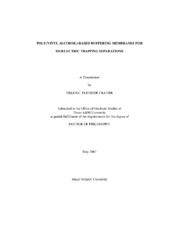| dc.description.abstract | Isoelectric trapping (IET) in multicompartment electrolyzers (MCE) has been widely used for the electrophoretic separation of ampholytic compounds such as proteins. In IET, the separation occurs in the buffering membranes that form a step-wise pH gradient in the MCE. Typically, buffering membranes have been made by copolymerizing acrylamide with Immobiline compounds, which are acidic and basic acylamido buffers. One major problem, however, is that these buffering membranes are not stable when exposed to high concentrations of acid and base due to hydrolysis of the amide bonds. Poly(vinyl alcohol)-based, or PVA-based, membranes were made as an alternative to the polyacrylamide-based membranes since they provide more hydrolytic and mechanical stability. Four mid-pH, PVA-based buffering membranes that contain single ampholytes were synthesized. These buffering membranes were used to trap small molecular weight pI markers for up to three hours, and were also used in desalting experiments to remove strong electrolytes from a solution of ampholytes. Additionally, the membranes were used in IET experiments to separate mixtures of pI markers, and to fractionate the major proteins in chicken egg white. The membranes did not show any degradation when stored in 3 M NaOH for up to 6 months and were shown to tolerate current densities as high as 16 mA/cm2. In addition, six series of PVA-based membranes, whose pH values can be tuned over the 3 < pH < 10 range, were synthesized by covalently binding aminodicarboxylic acids, and monoamines or diamines to the PVA matrix. These tunable buffering membranes were used in trapping experiments to trap ampholytes for up to three hours, and in desalting experiments to remove strong electrolytes from a solution of ampholytes. These tunable buffering membranes were also used in IET experiments to separate proteins, some with pI values that differ by only 0.1 pH unit. The tunable buffering membranes did not show any signs of degradation when exposed to 3 M NaOH for up to 3 months, and could be used in IET experiments with current densities as high as 20 mA/cm2. These tunable buffering membranes are expected to broaden the application areas of isoelectric trapping separations. | en |


